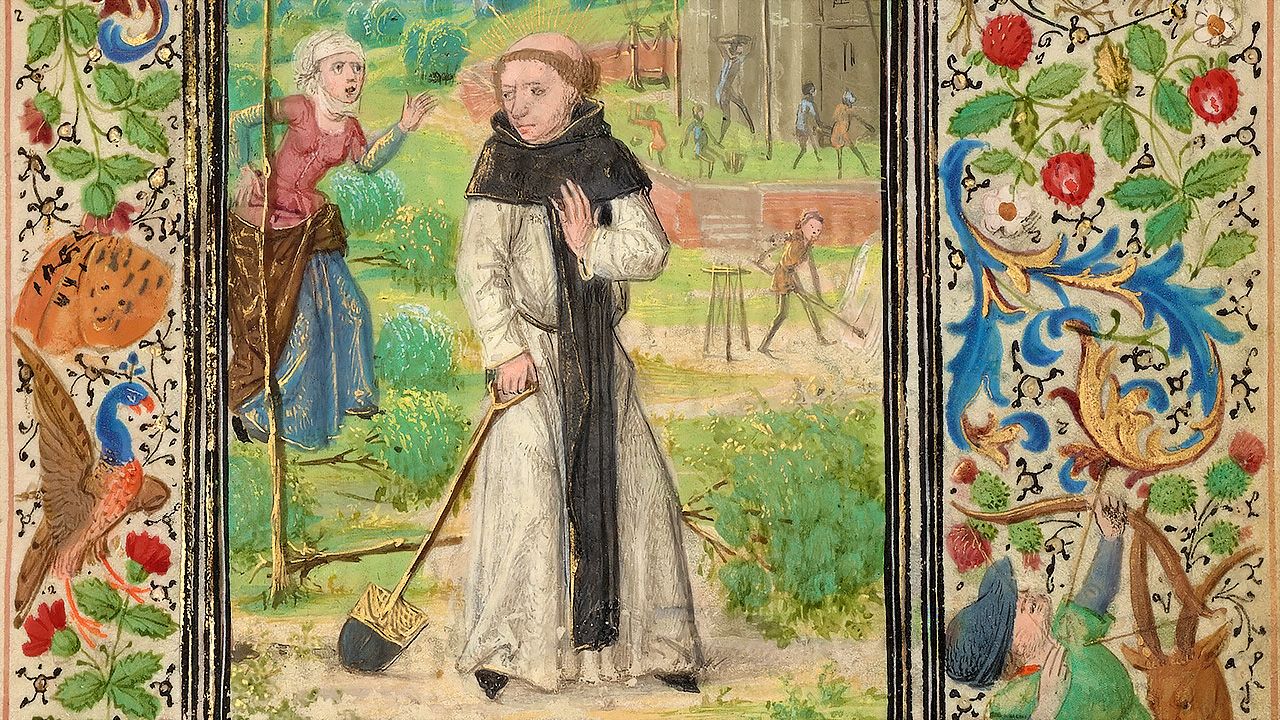In this continuation of our series on the history of Catholic herbal medicine, we explore the legacies of Saint Fiacre, Saint Gertrude of Nivellles, and Abbot Walafrid Strabo. Join us as Judson Carroll illuminates their enduring impact on herbalism in this excerpt from Christian Herbal Medicine, History and Practice.
Saint Fiacre
Saint Fiacre is the earliest canonized Patron Saint of herbal medicine. ...thanks to the heroic evangelization of Saint Patrick, [Saint Fiacre] was born into a Christian Ireland. His biography in the Tradition Order tells us:

St. Fiacre (fee-AH-krah) of County Kilkenny in Ireland is a patron saint of gardening, both vegetable and medicinal. He grew up in a monastery where he learned herbalism and his skill at it, together with his piety, were so noteworthy that it caused disciples to flock to him. Seeking greater solitude, he left and sought refuge near Meaux, France in a wooded area near the Marne River.
Saint Faro, the bishop of that area at the time, gave him a dwelling in a forest in the province of Brie. The legend is that St. Faro offered him as much land as he could turn up in a day, and that St. Fiacre, instead of driving his furrow with a plow, turned the top of the soil with the point of his staff. He then cleared the ground of trees which fell to either side of him as he walked the area with his staff, and there he made his garden, built an oratory in honor of the Blessed Virgin, and built a hospice for travelers which developed into the village of Saint-Fiacre in Seine-et-Marne.
In his hospice he entertained visitors and patients, treating them himself with herbs and other natural items, and that at times it’s said he miraculously restored some to health more immediately.

He died on August 18, 670 after years of prayer, mortification and labor in his garden. Visitors from Ireland and France would continue to come to his shrine for centuries after his death seeking healing and solace. His feast day is September 1.
St Gertrude of Nivelles
Unfortunately, less is known of Saint Gertrude.

St. Gertrude was born in Landen, Belgium in 626 A.D. She was a Benedictine abbess at a monastery in Nivelles, Belgium and, along with St. Fiacre, is a patron saint of herbalists and gardeners, though she is most renowned as a saint of house cats. She died on March 17, 659, and March 17 is her feast day, the same as St. Patrick.
Quoting further from the Tradition Order:
As can be seen, after Rome fell, the Benedictines quickly became the monastic masters of herbalism, already being focused on the mission of preserving knowledge. Among other things, they perfected the making of tinctures—suspending the essence of an herb in an alcohol base for medicinal and other purposes. Holy Roman Emperor Charlemagne (742-814 A.D.) so admired the Benedictine gardens and techniques that he ordered all monasteries throughout the empire to plant “physic gardens” to supply the monasteries and the empire with healing herbs.
In 820 A.D. Swiss Benedictines designed an architectural drawing of the ultimate monastery with their Plan of St. Gall. It showed a physic garden that was to contain two dozen herbs including rosemary, rue, sage, fennel, fenugreek, dill, cumin, mint, savory, pennyroyal, rose and watercress. It is the only remaining major architectural drawing from the 700 years between the fall of the Western Roman Empire and the thirteenth century, but it was never built.

Although there are very many Patron Saints for medicine and the healing of almost countless ailments, From Saint Raphael the Archangel to Saint Brigid of Ireland and probably hundreds more, so many would be associated with the Benedictines that it is hard to quantify just how influential the Monastic Medicine truly was. Undoubtedly, we owe the scholarly study of medicine after the fall of Rome to such simple and pious monks and nuns.
Of course, Saint Hildegard von Bingen warrants an entire chapter of her own! Stay tuned [in future posts]. But, first we must discuss the Abbot Walafrid Strabo.
Abbot Walafrid Strabo
The Abbot’s small book, entitled Hortulus, was the first herbal written by a classically educated man following the fall of the Roman Empire.
An article credited to S.E.S. Eberly, entitled "A 9th Century Garden, Walafrid Strabo's Hortulus" tells us:

Walafrid Strabo (808-849 CE), is remembered in large part because he has given us one of the very few first-hand descriptions of an early medieval garden.
Walafrid was sent as a child to the monastery of Reichenau, located on an island in Lake Constance, just north of the border between Germany and Italy. A remarkable student and writer, at the age of 18 Walafrid went to Fulda to study with renowned scholar Rabanus Maurus. From there, he was called to the court of King Louis, son of Charlemagne, to tutor 6-year-old Prince Charles. When Charles reached adulthood, Walafrid returned to Reichenau as its abbot.
Walafrid's Hortulus
Though he authored a number of scholarly works, Walafrid is best remembered for his Hortulus, or "Little Garden." Written in Latin verse, it begins with an explanation of how Walafrid gained his knowledge of gardening:
"I myself learned this, not solely from opinion, common report, nor from searches of books and early writings, but by work and hands-on study to discover proven methods -- which considerably postponed my leisure at the end of each day!"
Hortulus begins in early spring, when Walafrid is dismayed by rampant nettles "pushing up everywhere in my small plot." After hours of weeding, he carefully "surrounds the oblong beds with planks, slightly raised" to keep the rain from washing away the soil. He grows some plants from seed, some from cuttings. He hauls water in a bucket, pouring it "drop by drop, careful not to float the seeds away."
One part of his garden is beneath the edge of the roof where it gets little rain; another is deeply shaded by a high wall. But even so, "the garden traps no plant beneath its soil" and soon new growth pokes through.
What did his garden look like? Walafrid lists the plants he cultivates in his little garden, and perhaps -- we don't really know -- his list reflects the layout of his garden. A drawing in the Plan of St. Gall, a manuscript created at Reichenau at about the time that Walafrid arrived there as a boy, shows two monastery gardens. One, the physic garden, lies just beyond the door of the monastery infirmary. It is laid out in orderly rows of rectangular beds, each labeled in the manuscript so that we know what plants would be cultivated there.


|

|
Walafrid kept a notebook, or Vademecum, in which he documented his lifelong interest in the medicinal uses of plants. For every plant in his garden except the rose, he provided at least one therapeutic use, and it may be that his "little garden" was a physic garden, laid out along the same lines as the garden we see in the Plan of St. Gall. Drawing upon that, we can imagine Walafrid's garden, taking into account the plants themselves, companion plant strategies, needs for sun or shade, and plant height.
Translations of Strabo's Hortulus are very difficult to find in English. For this reason, I am sure no one will mind if I quote from this small book, written in Latin more than 1,200 years ago, translated by Raef Payne. I will include several of his passages on medicinal herbs, but omit the vegetables, gardening advice and such. I am exceedingly fond of this book, and hope you will find a copy to make your own! Strabo's name, by the way, means something like "the squint eyed", and it is no wonder as his books were painstakingly handwritten in a beautiful script.

Sage
There in the very front grows sage, sweetly scented.
It deserves to grow green forever, enjoying perpetual youth;
For it is rich in virtue and good to mix in a potion,
Of proven uses for many a human ailment.
But within itself is the germ of civil war;
For unless new growth is cut away it turns
Savagely on its parent and chokes to death
The older stems in bitter jealousy.
Rue
Here is a shadowed grove which takes its color
From the miniature forest of glaucous rue.
Though its leaves are short and the small umbels which rise
Like clusters of spears it sends the wind's breath
And the sun's rays down to its roots below.
Touch it but gently and it yields a heavy
Fragrance. Many a healing power it has -
Especially, they say, to combat
Hidden toxin and to expel from the bowels
The invading forces of noxious poison.
Southernwood
Admire too the tall bushes of southernwood
With their bloom of down and sharp spikes
Which grow on its wealth of branches like finest hair.
It is good to mix the scented sprigs, plucked
With the supple stem into healing medicines.
It has power against fevers, banishes stitch, and if
Your limbs ache with the elusive and mysterious
Pain of gout, it will bring relief. Indeed
As many virtues it has as strands of foliage.
Wormwood
The next bed grows rushes of bitter wormwood. Its supple stem
Resembles the Mother of Herbs, but the leaves have a different color.
The smell of its downy branches are different too, and the brew
It makes has a bitterer taste by far.
Its powers are famous
Its effectiveness proven. It tames a raging thirst; fever
It banishes. If, besides, your head should suddenly start to
Throb and throb with pain, if fits of fainting worry you,
Seek its help:
Boil the bitter stem of a plant
In leaf, tip the brew into an ample basin
And pour it over the top of your head. Then having bathed
Your soft hair and the liquid make a garland of leaves
(Do not forget this) and put it on, so that the bandage
Gently binds your hair and holds the warmth in it.
A few hours later - not many - you will be marveling
At this yet further proof of the healing powers of the wormwood.
Horehound

Horehound comes next and what shall I say of this
Powerful worker? A precious herb, though biting
And sharp on the tongue where it tastes so unlike
Its scent; for whereas the scent is sweet, the taste
Is not sweet at all, Yet taken in a draught
For all its nastiness it assuages pain
In the chest, and when drunk still warm from the fire
And ladled quickly to close the meal.
If ever
A vicious stepmother mixes in your drink
Subtle poisons or makes a treacherous dish
Of lethal aconite for you, don't waste a moment -
Take a dose of wholesome horehound; that
Will counteract the danger you suspect.
Fennel
Let us not forget to honor fennel. It grows
On a strong stem and spreads its branches wide.
Its tastes is sweet enough, sweet too its smell;
They say it is good for eyes whose sight is clouded,
That its seed, taken with milk from a pregnant goat,
Eases a swollen stomach and quickly loosens
Sluggish bowels. What is more, your rasping cough
Will go if you take fennel-root mixed with wine.
Iris
And I must not pass you by, my iris, in silence
Latin, that rich and eloquent tongue, has given you
The name Gladiola, made from its word for a sword.
For me at the start of summer you put forth
The beauty of your purple flower, which serves
(A charming office!) for the violet dark and small
Or the fresh-faced boy, who died springs up under
Apollo's high altar, and signs the boy's name
On the tip of its flower.
Of your root, crush them and dissolve them in wine.
With this preparation (none else is so good) we relieve
Griping pains in the bladder. With your help too
The laundryman can stiffen his shining linen
And scent it sweetly.
Lovage
Here in this fragrant thicket is sturdy lovage.
So deep is my love for this little garden of mine,
I have to mention it. Although its juice and smell
Are thought to injure the eyes and bring the shadow of blindness,
Yet its tiny seeds are often added to cunningly blended
Cures, winning fame for praise due to others.
Chervil
Come holy Muse, who in sacred song
Canst stablish monuments of mighty wars
And mighty deeds - come, scorn not, touch with me
The humble riches that my garden yields.
Now Chervil, though it splits and divides itself
In flimsy branches and gives but a paltry seed
In its thick clusters of ears, yet flourishing
All the year through gives largess to the poor
And comfort
A drought of this, so easy to take
Will counter and check internal bleeding. Again
When mixed with pennyroyal and poppy leaves
It makes a poultice which will prove effective
For a stomach that's upset and wracked with pain.
Lily
Now the lily, and ah! What lines can my simple Muse.
Lean and meagre as she is, find to praise
The shining lily? Its white is the white of glistening snow,
Its scent is the scent of sweet frankincense.
Not Parian marble in whiteness, not spikenard in fragrance
Surpass our lily.
If a snake, treacherous and wily,
As it is by nature; plants with deadly tongue its parcel
Of venom in you, sending grim death through the unseen wound
To the innermost vaults of the heart - then crush lilies with a weighty
Pestle and drink the juice in wine. Now place the pulp
On top of the livid spot where the snake's tongue jabbed;
Then indeed you will learn the wonderful power
This antidote has. Nor is that all: This same pulp
Of crushed lily is good for limbs that are twisted awry.
Poppy
Here in this tale of trifles let me speak of Circe's poppy -
Hers it is because, mourning the loss of her stolen daughter
She is said to have eaten poppy to drown her sorrow, deep
Beyond measure - to forget, as she longed to forget, her grief of mind.
The poppy will often help to check that dark ulcer,
Deep in the chest, which send to the mouth that foul and acrid
Belch. Its head loaded with tiny grains, is held high
On a long delicate neck and, like the Phoenician pomegranate,
Under the broad mantle of a single skin it holds
A mass of seeds of remarkable power. The sound of chewing
(from a Latin word) gave it the name we know it by now.
Clary

Here, casting its shadow among the fresh verdure
Grows clary, rising on sturdy stalk
And sending high and higher still
Its branch and leaf. Its help is rarely
Sought for cures; the doctor's hand,
You might almost think, had missed it.
But when it is put in soft, warm water
It yields a goodness, makes a brew
Which is sweetly scented.
Near it lurks
(But not forgotten) a bush of garden
Costus, whose root when cooked will move
With its wholesome aide the sluggish stomach.
Mint
I shall never lack a good supply of common mint,
In all its many varieties, all its colors, all
Its virtues. One of its kind is thought to be good for the voice:
If a man who is often troubled with hoarseness wets his dry
Throat with julep of mint, the roughness will go and the tone
Come clear.
Another kind there is, with different scent
And rather harsher taste, which grows very thick. Its full
Spread of leaf casts no mean shadow; but like the danewort
it aims high on its strong stem and stretches its wings
Of leaf on every side...
But if any man can name
The full list of all the kinds and all the properties
Of mint, he must be one who knows how many fish
Swim in the Indian Ocean, how many sparks Vulcan
Sees fly in the air from his fast furnace in Etna.
Pennyroyal

The humble scale of my song will not allow me
To embrace in fleeting verse the many virtues
Of pennyroyal. They say that Eastern doctors
Will pay as much for it as we pay here
For a load of Indian pepper. Since such a people,
Rich as they are, blessed with gold and ebony,
Who give to an eager world a wealth of marvels -
Since they will buy at such a price, so greedily,
Our pennyroyal, who can doubt its power
To allay a host of troubles?
Oh, how wise,
How good is God! Let us praise him as we ought.
From no land He withholds His bounty; what is rare
Beneath this sky, under another lies
In such abundance as the cheapest trash
We have among us here: some things we scorn
Rich kingdoms pay great prices for. And so
One land helps another; so the whole world,
Through all its parts makes one family.
Believe me my friend, if you cook some pennyroyal
And use it as a potion or a poultice, it will cure
A heavy stomach - that you can take for truth.
Some things are only hearsay, but custom and usage
Allow us to blend them in with lofty truth - like this:
When the sun is blazing down on you in the open,
To prevent heat from harming your head, put a sprig
Of pennyroyal behind your ear...
Ah me
If my impatient Muse were not now forcing me
To take in sail and make for last harbor,
Many another flower I could gather for you.
Celery
Celery is now held cheap in our garden and many think
Taste is its only merit. But it has virtues
And offers quick help in many remedies. If you grind
The seeds and take them, they are said to banish the racking pains
Of a troubled bladder. If you chew them together with the tender buds
It helps digest the food as it moves through the innermost parts
Of the system. And if the stomach, that king of the body, is sick,
Hurry to take a draught of water and sour vinegar
With celery: the discomfort will pass, routed and quickly cured.
Betony
In the mountains and the woods, in the meadows and the depths of the valleys -
Almost everywhere, far and wide, grows the precious abundance
Of betony. Yet, I have it too in my garden, and there
It learns a softer way of life in the tended soil.
So great is the honor this genus has won for its name
That if my Muse wished to add to it she would find herself
Defeated at last, overwhelmed; and soon she would see
She could add nothing more to the value it has already.
Perhaps you pick it to use green, perhaps
To dry and store for the sluggish winter.
Do you like to drink it from cloudy goblets? Or do you
Prefer to enjoy what it gives after a long and careful
Refining? Whatever your fancy, the wonderful powers
Of this herb will supply all your needs.
Indeed, some men I know rate it so highly
That, hoping to find protection against every harm
Which assaults the inner body, day after day
They drink a dose of this harsh but soothing tonic.
Again, if your head is cut and the wound turns septic.
Crush some sacred betony, make of it dressings
Apply them frequently: you will be amazed
How quickly its powerful influence closes the wound.
Agrimony
And here in handsome rows you can see my agrimony.
It clothes all fields with its profusion; it grows
Wild in the woodland shade. Much honor it has and many
Virtues - among them this: if it's crushed and drunk
The draught will check the most violent stomachache.
And if an enemy blade happens to wound us
We are recommended to try its aid, pounding the shoots
And putting them on the open place.
If we remember to add to the dressing some sharp
Vinegar, our full strength will soon be restored.
Tansy

Not far away grows tansy, commonly called
Ambrosia. Famous it certainly is, but whether
That is the same ambrosia so often mentioned
In ancient writings, many would doubt. However,
The doctors use it for the powers it has.
A drought of it clears away as much blood inside
As the size of the dose you take of this nourishing brew.
Catmint
Among the herbs in my garden is always renewing
The sprigs of catmint grow as briskly as any
its leaves are like nettles, but its scent casts
So lavishly around its tall head is passing sweet.
It has long been known as a cure for many ailments
And ranks high among herbs. Mixed with oil of roses,
The juice makes and ointment, which they say can clear
The hurt of a wound and the unsightly marks of a scar,
Restoring the bloom of the skin and renewing the hair
Which the blood and puss of a gaping sore have eaten away.
Radish
Here, in the last row of all, the radish
Roots itself strongly and raises its leaves in a broad
Canopy. Chew the root - though it's rather hot -
To check a spasm of coughing; the troublesomeness
Of that same complaint can often be cured
If you grind the seeds in a potion and swallow it down.
Abbot Strabo ends his book with a dedication to a fellow priest to whom he entrusted his work. He closes with this prayer:
God give you the crown of eternal life, the palm that is green forever. To this my prayer may the Father, the Son and the Holy Ghost grant Their amen.
Judson Carroll is a Certified Master Herbalist from the blue Ridge Mountains of North Carolina, who began his herbal apprenticeship at age 15. He is the author of 7 books on Herbal Medicine and Gardening and he hosts the Southern Appalachian Herbs Podcast. His weekly articles on herbal medicine are available through his Substack. Judson is a convert to Catholicism, who is orthodox in doctrine and very traditional… but still struggling to learn Latin, and the only guy in his parish with a southern accent! He may be contacted at southernappalachianherbs at gmail.com.



